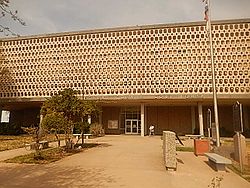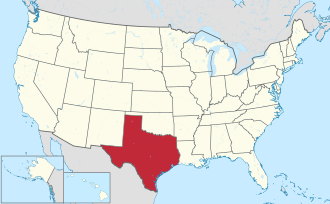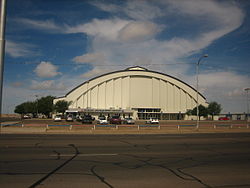Demographics
Historical population| Census | Pop. | Note | %± |
|---|
| 1890 | 224 | | — |
|---|
| 1900 | 381 | | 70.1% |
|---|
| 1910 | 1,178 | | 209.2% |
|---|
| 1920 | 760 | | −35.5% |
|---|
| 1930 | 3,958 | | 420.8% |
|---|
| 1940 | 15,051 | | 280.3% |
|---|
| 1950 | 42,102 | | 179.7% |
|---|
| 1960 | 90,995 | | 116.1% |
|---|
| 1970 | 91,805 | | 0.9% |
|---|
| 1980 | 115,374 | | 25.7% |
|---|
| 1990 | 118,934 | | 3.1% |
|---|
| 2000 | 121,123 | | 1.8% |
|---|
| 2010 | 137,130 | | 13.2% |
|---|
| 2020 | 165,171 | | 20.4% |
|---|
| 2024 (est.) | 170,022 | [6] | 2.9% |
|---|
|
Ector County, Texas – Racial and ethnic composition
Note: the US Census treats Hispanic/Latino as an ethnic category. This table excludes Latinos from the racial categories and assigns them to a separate category. Hispanics/Latinos may be of any race.| Race / Ethnicity (NH = Non-Hispanic) | Pop 2000 [11] | Pop 2010 [9] | Pop 2020 [10] | % 2000 | % 2010 | % 2020 |
|---|
| White alone (NH) | 61,168 | 56,306 | 51,023 | 51.33% | 41.06% | 30.89% |
| Black or African American alone (NH) | 5,370 | 5,596 | 7,430 | 4.43% | 4.08% | 4.50% |
| Native American or Alaska Native alone (NH) | 526 | 623 | 568 | 0.43% | 0.45% | 0.34% |
| Asian alone (NH) | 744 | 1,004 | 2,257 | 0.61% | 0.73% | 1.37% |
| Pacific Islander alone (NH) | 31 | 106 | 327 | 0.03% | 0.08% | 0.20% |
| Other race alone (NH) | 29 | 68 | 492 | 0.02% | 0.05% | 0.30% |
| Mixed race or Multiracial (NH) | 949 | 1,096 | 3,023 | 0.78% | 0.80% | 1.83% |
| Hispanic or Latino (any race) | 51,306 | 72,331 | 100,051 | 42.36% | 52.75% | 60.57% |
| Total | 121,123 | 137,130 | 165,171 | 100.00% | 100.00% | 100.00% |
As of the census [12] of 2000, 121,123 people, 43,846 households, and 31,700 families resided in the county. The population density was 134 people per square mile (52 people/km2). The 49,500 housing units averaged 55 units per square mile (21/km2). The racial makeup of the county was 73.69% White, 4.61% African American, 0.83% Native American, 0.64% Asian, 0.04% Pacific Islander, 17.38% from other races, and 2.81% from two or more races. About 42.36% of the population was Hispanic or Latino of any race.
Of the 43,846 households, 38.90% had children under the age of 18 living with them, 54.10% were married couples living together, 13.70% had a female householder with no husband present, and 27.70% were not families. About 24.00% of all households was made up of individuals, and 8.90% had someone living alone who was 65 years of age or older. The average household size was 2.72 and the average family size was 3.25.
In the county, the population was distributed as 30.40% under the age of 18, 10.50% from 18 to 24, 27.90% from 25 to 44, 20.20% from 45 to 64, and 10.90% who were 65 years of age or older. The median age was 32 years. For every 100 females, there were 94.70 males. For every 100 females age 18 and over, there were 90.90 males.
The median income for a household in the county was $31,152, and for a family was $36,369. Males had a median income of $30,632 versus $21,317 for females. The per capita income for the county was $15,031. About 16.10% of families and 18.70% of the population were below the poverty line, including 23.90% of those under age 18 and 14.30% of those age 65 or over.
This page is based on this
Wikipedia article Text is available under the
CC BY-SA 4.0 license; additional terms may apply.
Images, videos and audio are available under their respective licenses.





